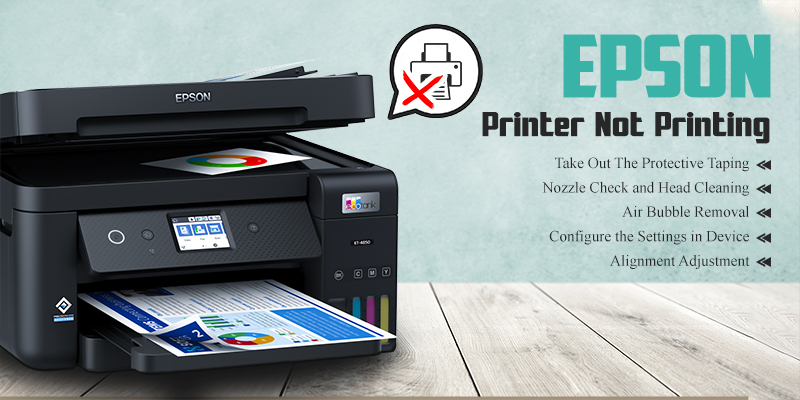
Why Is My Epson Printer Not Printing When The Ink is Full
Introduction:
Owning a printer is undeniably convenient until you encounter the confounding situation of your Epson printer refusing to print despite indicating full ink levels. This scenario often leaves users perplexed and frustrated, wondering why a seemingly simple task has become a daunting challenge. In this comprehensive guide, we will delve deeper into the potential reasons behind this issue and explore detailed solutions to help you get your Epson printer back to its efficient, ink-splattering self.
1. Check for Firmware and Driver Updates:
One of the most common yet often overlooked reasons for printing issues is outdated firmware or printer drivers. Epson regularly releases firmware updates to enhance printer performance and resolve compatibility issues. Similarly, having the latest printer drivers installed on your computer is crucial for seamless communication between the device and your printer. Visit the official Epson website to download and install the latest firmware and drivers compatible with your printer model.
2. Verify Ink Cartridge Installation:
Before delving into complex troubleshooting, it’s essential to revisit the basics. Incorrectly installed or loose ink cartridges can disrupt the communication between the printer and the ink supply, leading to printing errors. Ensure that each ink cartridge is securely and correctly inserted into its designated slot. Consult your printer manual for specific instructions on proper cartridge installation.
3. Clean the Printhead:
Over time, printheads can accumulate dried ink, resulting in clogs that impede the printing process. Many Epson printers feature a built-in printhead cleaning function accessible through the printer settings. Running a printhead cleaning cycle helps remove dried ink and clear any blockages. Refer to your printer’s manual for instructions on how to initiate the printhead cleaning process.
4. Perform a Nozzle Check:
If you suspect issues with the printhead, performing a nozzle check is a valuable diagnostic tool. This test prints a pattern that allows you to identify any clogged or misfiring nozzles. If the nozzle check reveals inconsistencies, follow the printer’s manual instructions for additional nozzle cleaning or use the automated cleaning utility provided in the printer software.
5. Use Genuine Epson Ink Cartridges:
While third-party ink cartridges may seem like a cost-effective solution, they can sometimes lead to compatibility issues with your Epson printer. Genuine Epson ink cartridges are designed to meet the printer’s specifications, ensuring optimal performance and reducing the likelihood of printing problems. Consider switching to genuine cartridges to eliminate potential compatibility issues.
6. Check for Low Ink Warnings:
Even if your ink levels appear full, some Epson printers issue low ink warnings based on factors such as the age of the cartridge or the number of pages printed. If you receive a low ink warning, consider replacing the cartridge, even if the ink levels seem sufficient. This preemptive measure can prevent printing issues related to depleted ink.
7. Resolve Connectivity Issues:
Issues with printing may stem from connectivity problems between the printer and your computer. Verify that your Epson printer is correctly connected, whether through a USB or a wireless connection. Troubleshoot any network or cable issues that may be hindering communication. Re-establishing a stable connection can often resolve printing glitches.
8. Run a Printer Diagnostic:
Epson printers often come equipped with diagnostic tools designed to identify and resolve common issues. These tools may be accessible through the printer’s control panel or included in the software that accompanies the printer. Running a diagnostic can provide valuable insights into specific problems and guide you through the troubleshooting process step by step.
9. Check for Paper Jams:
Paper jams are a perennial cause of printing malfunctions. Despite seemingly having sufficient ink, a paper jam can bring your printing process to a halt. Open your printer carefully and inspect for any stuck paper, removing it if necessary. Additionally, ensure that the paper is loaded correctly in the tray to prevent future jams.
10. Consult Epson Support:
If all else fails and the issue persists, it’s time to seek assistance from Epson’s customer support. Epson provides various support channels, including online chat, phone support, and a comprehensive knowledge base. Contacting Epson support allows you to receive personalized guidance based on your specific printer model and the issues you’re facing. Their expert support team can offer tailored solutions to get your printer back on track.
Conclusion:
In conclusion, addressing the challenge of an Epson printer not printing despite full ink levels requires a systematic and patient approach. From checking for firmware updates to ensuring proper ink cartridge installation, each troubleshooting step plays a crucial role in identifying and resolving the underlying issues. The versatility of Epson printers, combined with the comprehensive solutions outlined in this guide, empowers users to troubleshoot and resolve printing problems with confidence. Remember, Epson’s customer support is always available to assist, ensuring that you can enjoy a seamless and efficient printing experience. Happy printing!


